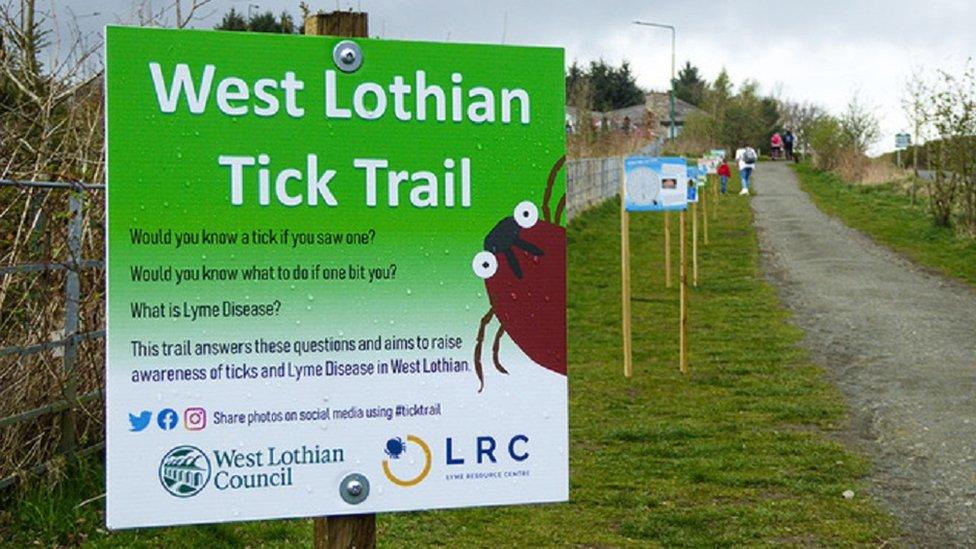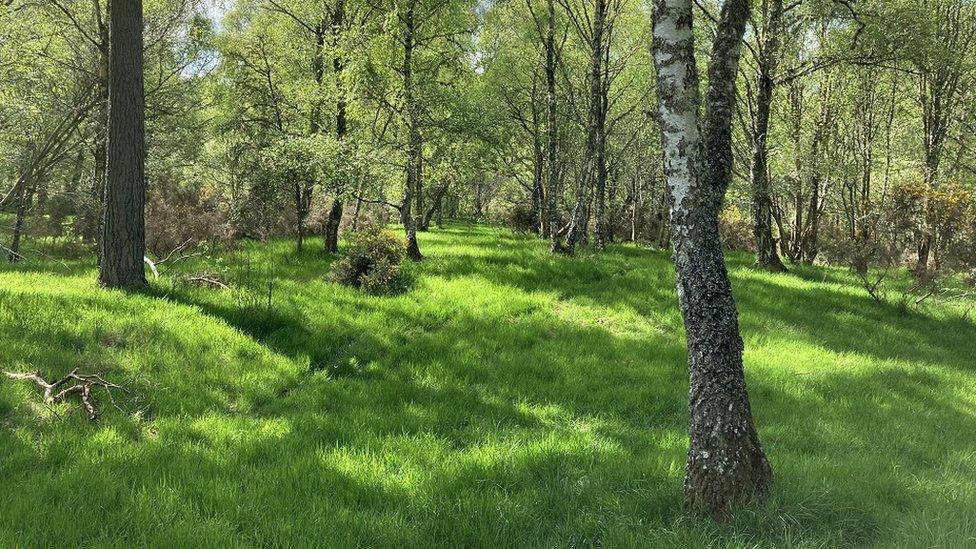Warning ticks year-round risk due to climate change
- Published

Lyme disease can be spread to humans from an infected tick bite
Ticks have become a year-round threat because of climate change, experts have warned.
Lyme disease, a bacterial infection which causes a range of health problems, can be spread to humans from some tick bites.
The tiny parasitic spider-like creatures are usually active from early spring to late autumn.
But scientists and Lyme disease charities said milder recent winters had extended the UK's tick "season".
Annette Davies, of Lower Largo, Fife, said a tick bite in February 2016 had a huge effect on her life.
Following a dog walk through fields near her home, she suffered flu-like symptoms and bullseye rashes - a symptom of Lyme disease.
She said she went from a busy, full-time working mother and grandmother to being barely able to walk upright.
"I still suffer fatigue and have relapses if I overdo things," she said.

Annette Davies said a winter tick bite left her with Lyme disease

Charities are among those warning that ticks pose a potential risk beyond spring and autumn.
"We are seeing cases of Lyme disease in Scotland in the winter months, as the winter season is milder than a decade ago," said Prof John Lambert, of Fife-based Lyme Resource Centre.
"We are getting more reports of increased numbers of ticks and people presenting with signs and symptoms of Lyme disease outside the classic time ticks are active."
Lyme Disease UK said while ticks continued to be far more prevalent between spring and autumn, it was aware of the bloodsucking pest posing a risk at other times.
A spokeswoman said: "We are certainly seeing people coming to us for advice all year round regards tick bites.
"This could perhaps be linked to the changing climate as the UK as a whole is experiencing milder winters with more rainfall - ideal conditions for ticks."

A public awareness sign about ticks installed by West Lothian Council and Fife-based Lyme Resource Centre
What makes viruses tick?, external - a project led by the Brennan Lab at the MRC-University of Glasgow Centre for Virus Research - has also noted tick sightings in winter, particularly on the Isle of Harris in the Western Isles.
The isles have previously been identified as having a climate that allows the creature to thrive.
The project team said milder winters may have stopped ticks from dying off.

Lyme disease: 'I felt like I was being drowned'

Morven-May and her cavapoo Ember
Morven-May MacCallum was a teenager when she was bitten by an infected tick.
Her Lyme disease, which was initially misdiagnosed, has caused her 16 years of ill-health.
The Highlands-based author said: "I was housebound for eight years.
"I was so weak I couldn't walk. I became very thin because everything in my body was going towards fighting this disease.
"I really was a shell of what I was. I was trapped inside the four walls of my bedroom.
"I had such huge plans for my life - I was going to go to university, I was someone who was very active with horse riding and going up Munros, I did volunteer work at the local animal rescue centre. I was someone who didn't sit still.
"To go from a life that was so big to one so small was just horrendous. The symptoms were so overpowering. I felt like I was being drowned."
Morven-May said Lyme disease continued to be a fixture of her life, causing fatigue, constant aches and pains and difficulties recalling words when speaking. For the last four years she has been raising awareness about the disease.
While she was bitten during the more usual tick season, she has encountered ticks on her dog, Ember, in winter.
Morven-May said: "I am very aware ticks are becoming increasingly active because of changes in our environment.
"I wasn't surprised to find a tick, but I was disappointed. It pops the illusion that maybe you're safe during winter."

Not all ticks result in Lyme disease, and the disease is also treatable if caught early.
Laboratory-confirmed cases of Lyme disease in England and Wales have risen steadily since reporting began in 1986 although yearly fluctuations have been observed, according to the UK Health Security Agency, external.
Since 2018, when there were 1,636 cases, there has been a slight decrease in annual rates. However, the agency said it was unclear what impacts the Covid pandemic has had on the figures. In 2020 there were 1,262 cases recorded and 1,156 in 2021.
Health Protection Scotland's, external latest figures show there were 287 provisional cases in 2020. There were 308 in 2019.

Ticks can often be encountered in grassy woodland areas
A newly-launched pilot project led by NHS Highland, Scotland's Rural College and Covid jag manufacturer Pfizer Inc, which is working on a Lyme disease vaccine, aims to gather even more accurate case numbers for some parts of the UK.
Forty GP practices in Scotland and 10 in England are being asked to collect data on the disease until the end of 2022.
Ticks can be found in public parks and even gardens, though traditionally "high-risk" places for ticks include grassy and wooded areas in southern and northern England and the Scottish Highlands, according to the NHS.
They feed on a range of animals, including birds, deer, sheep, cats and dogs. People can come into contact with ticks from their pets.
University of Liverpool's Small Animal Veterinary Surveillance Network has recorded potential tick hotspots in parts of Scotland and England because of higher numbers of pets found with ticks during vet consultations, external.
The British Veterinary Association said ticks present risks to animals as well as humans.
President Justine Shotton said: "Prevention is always better than cure and we recommend that all animal owners discuss tailored parasite control, including tick prevention, with their vet."
Outdoors organisation Mountaineering Scotland frequently issues warnings on ticks in the Scotland's countryside and wild places.
And it said even Scotland's mountains did not offer refuge from the parasite.
Davie Black, conservation and access officer for Mountaineering Scotland, said: "The science on tick distribution is always evolving, and studies have indicated that ticks can be found at higher altitudes than thought before due to expansion in the range of voles, which can host ticks."
He said weather patterns could be a factor behind the movement of voles, and their unwelcome passengers.

Ticks and Lyme disease
Advice on ticks and Lyme disease can be found online, including at the following websites:

- Published3 July 2021

- Published29 March 2021

- Published22 August 2019
